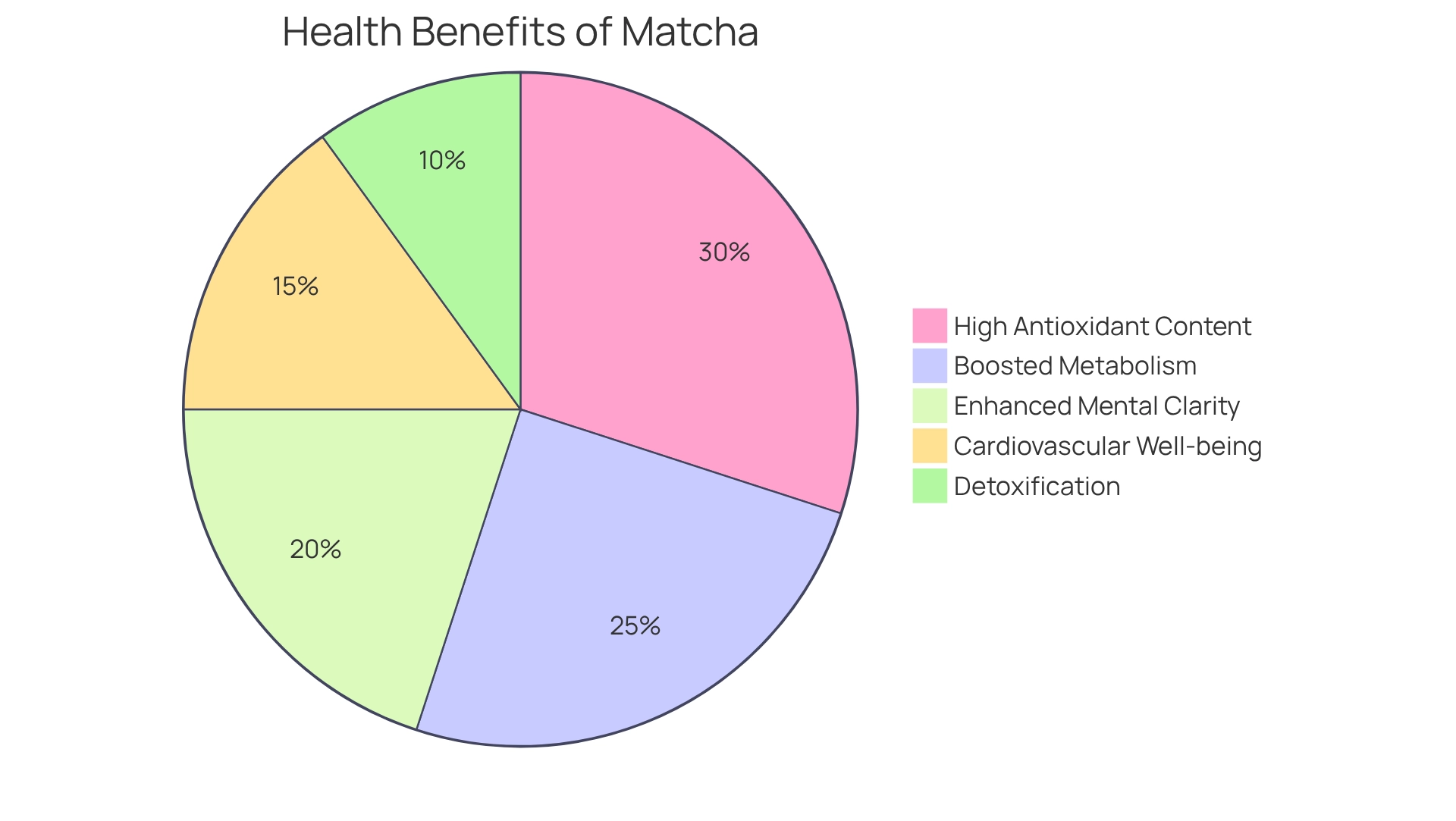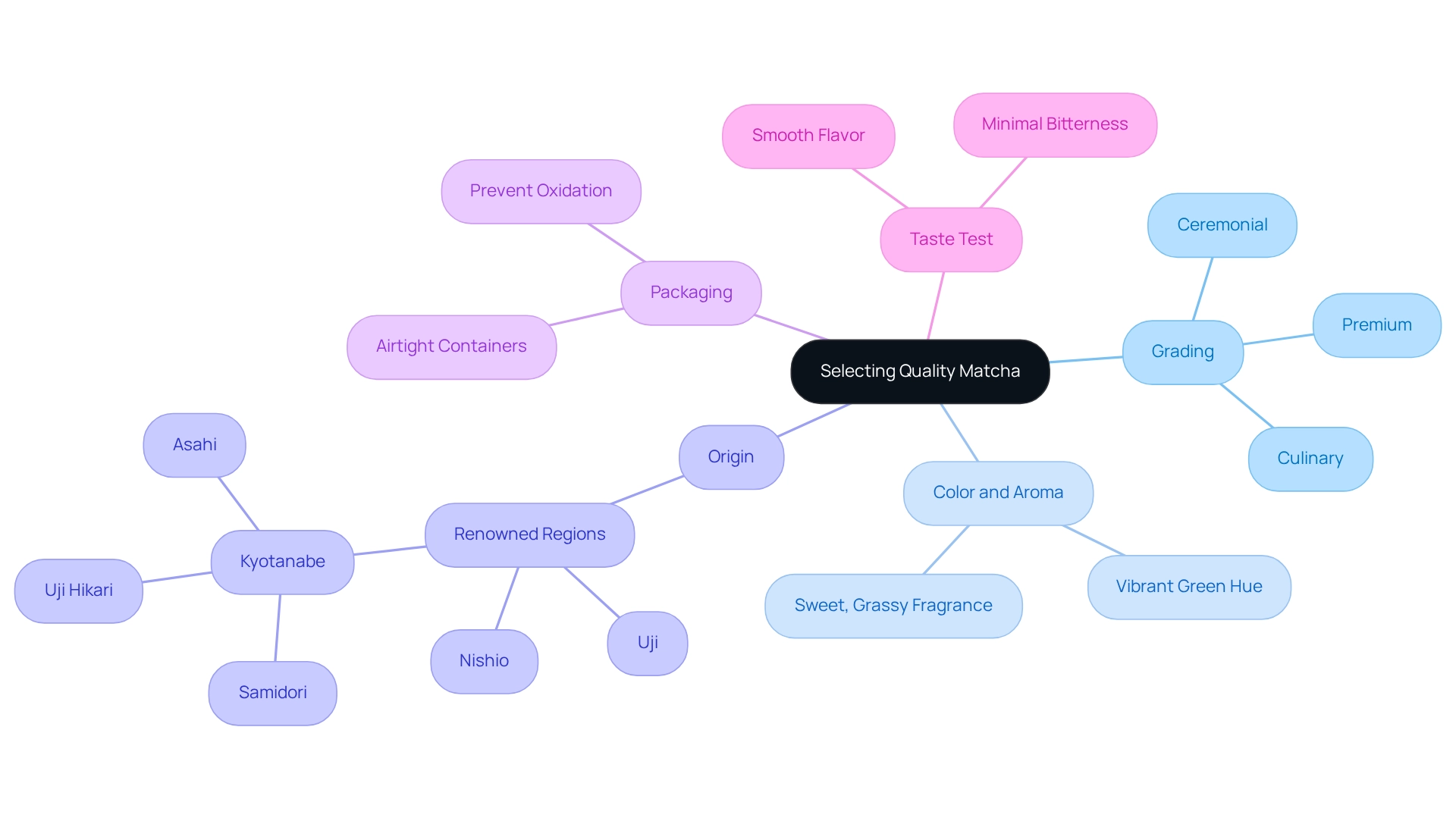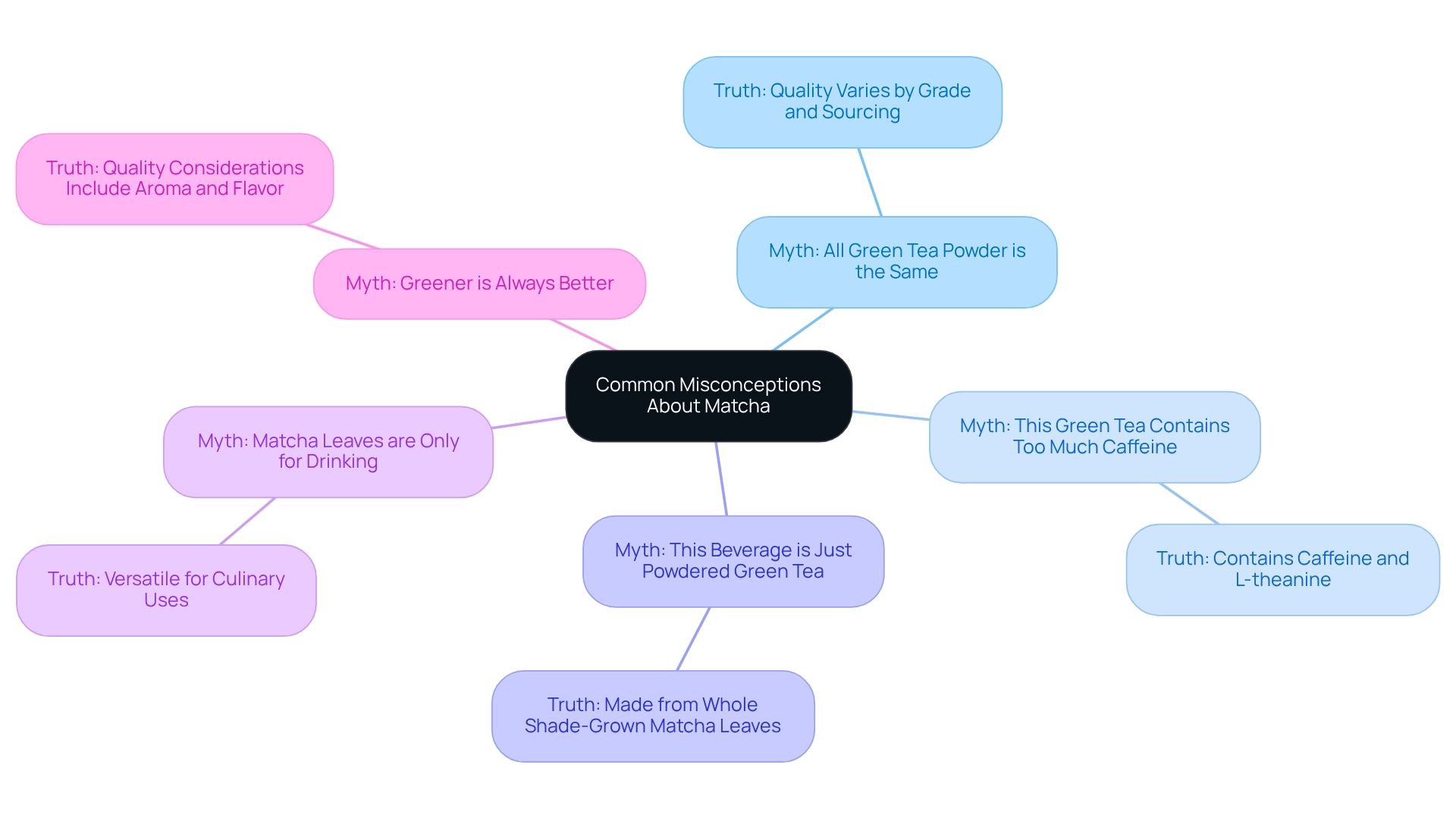Mastering Matcha Leaves: Essential Tips for Daily Wellness

Overview
Mastering matcha leaves is about more than just the leaves themselves; it’s a journey into their origins, their remarkable health benefits, and how they can seamlessly fit into your daily wellness routine. Imagine starting your day with a boost of energy and clarity—matcha offers that and so much more. With its high antioxidant content, matcha not only enhances mental clarity but also supports your overall well-being.
Incorporating matcha into your life can be as simple as adding it to your favorite smoothies or lattes. These delicious options make it easy to enjoy the powerful benefits of matcha while savoring each moment. As you explore the various ways to enjoy matcha, consider how it can enrich your health-focused lifestyle.
We invite you to take a step towards better health by embracing matcha. Whether you’re seeking to improve your focus or simply enjoy a delightful drink, matcha is a nurturing addition to your wellness journey. Explore the possibilities and discover how this vibrant green tea can transform your daily routine.
Introduction
With its vibrant green hue and rich cultural history, matcha has transcended its origins to become a global sensation. This finely ground powder, derived from specially cultivated green tea leaves, is not only a staple of traditional Japanese tea ceremonies but also a powerhouse of health benefits. From boosting metabolism to enhancing mental clarity, matcha is celebrated for its remarkable properties that promote overall wellness.
As you embark on your wellness journey, you may find yourself seeking natural solutions to support your health. Understanding how to incorporate this superfood into your daily routine, while recognizing the importance of quality sourcing, has never been more essential. This article delves into the origins, benefits, and practical tips for integrating matcha into a health-focused lifestyle. Moreover, it aims to dispel common misconceptions surrounding this beloved green tea, inviting you to explore its many wonders.
Understand Matcha: Origins and Health Benefits
This finely ground powder made from matcha leaves, derived from specially cultivated green tea, boasts a rich history that traces back to China during the Tang Dynasty (618-907 AD) and was later refined in Japan, where it became a cornerstone of the traditional tea ceremony. This vibrant green powder is celebrated for its exceptional antioxidant properties, particularly catechins, which contribute to a myriad of health benefits:
- High Antioxidant Content: Matcha is renowned for containing up to 137 times more antioxidants than regular green tea. This remarkable quality effectively combats oxidative stress and inflammation, which are linked to various chronic diseases. Recent studies have demonstrated that the residue portion of green tea alone provides comparable health benefits to medium and high concentrations of it, reinforcing its effectiveness.
- Enhanced Mental Clarity: The presence of L-theanine, an amino acid found in green tea, promotes a state of relaxation without inducing drowsiness, thereby enhancing focus and cognitive function. However, it is important to note that the evidence regarding the effects of this tea on cognitive function is still limited. As Sara Sokary from Qatar University states, "Overall, the evidence regarding the effect of this tea on cognitive function, cardio-metabolic function, and anti-tumor role is still limited, and conclusions cannot be drawn."
- Boosted Metabolism: Regular intake of matcha leaves has been shown to elevate metabolic rates, supporting weight management efforts. This aligns with the growing consumer demand for natural wellness solutions that can be easily integrated into daily routines.
- Cardiovascular Well-being: Studies suggest that this green tea may assist in lowering cholesterol levels and decreasing the likelihood of heart disease, aiding overall cardiovascular fitness.
- Detoxification: The chlorophyll content in matcha leaves aids in detoxifying the body, promoting overall wellness.
Including green tea powder in your daily routine can result in considerable well-being enhancements, making it an essential part of any wellness plan. Recent studies have emphasized the potential of this green tea to improve inflammatory responses and oxidative stress, further highlighting its role in promoting well-being. As the demand for natural wellness solutions continues to increase, this green tea stands out as a powerful ally in achieving a balanced and health-focused lifestyle.
Gardenika's dedication to quality and sustainability guarantees that their green tea offerings, made from organic ingredients, correspond with these health benefits. This commitment makes them a favored option for health-aware consumers seeking relaxation and immune support.

Incorporate Matcha: Daily Usage Tips and Techniques
Including green tea powder in your daily routine can be both enjoyable and beneficial, especially with Gardenika's premium organic options. Imagine starting your day with a nourishing ritual that not only energizes you but also supports your well-being. Here are some practical tips to seamlessly integrate this superfood into your life:
- Morning Ritual: Why not replace your morning coffee with a soothing cup of Gardenika green tea? Whisk 1-2 teaspoons of matcha leaves with hot water (not boiling) to create a smooth, energizing beverage. This delightful drink can enhance your focus and vitality. The catechins in green tea offer an energy boost while promoting digestive well-being—essential for a robust immune system.
- Smoothies: Looking to elevate your morning smoothie? Incorporate a teaspoon of Gardenika green tea powder. It pairs beautifully with fruits like bananas and spinach, providing a rich source of antioxidants that support overall wellness and help prevent diseases.
- Cooking: Consider adding matcha leaves into your baking recipes, such as muffins or pancakes. This not only enhances flavor but also brings wellness advantages, aiding in better digestion and overall well-being.
- Green Tea Latte: Create a creamy green tea latte by mixing matcha leaves powder with steamed milk (dairy or plant-based). Sweeten it with honey or agave syrup for a delicious twist that can serve as a comforting afternoon pick-me-up. This delightful method allows you to appreciate the wellness advantages of matcha leaves throughout your day.
- Snacks: Why not incorporate Gardenika green tea powder into your snacks? Try adding it to energy balls or chia seed pudding for a nutritious treat that satisfies cravings while providing wellness benefits. Consistently including green tea powder in your snacks can help reinforce healthy habits.
As Dr. Paria Vaziri wisely states, "Sometimes, adding one small habit to your days can make a bigger impact than you think." Experimenting with these methods can help you discover your favorite way to enjoy Gardenika tea, enabling you to reap its numerous health advantages, including improved digestion and increased immune support. With over 2000 five-star reviews, Gardenika's green tea selections are a trusted choice for those seeking to enhance their wellness routine.
Insights from case studies on daily inclusion of green tea indicate that individuals have successfully integrated it into their lives, enhancing their overall well-being. Remember, all Gardenika products are USDA Organic and Kosher certified, ensuring the highest quality for your health-conscious lifestyle.
![]()
Select Quality Matcha: Sourcing and Grading Insights
When choosing green tea powder, understanding its quality and grading is crucial for your wellness journey. Here are essential factors to consider:
- Matcha leaves are generally classified into three grades: ceremonial, premium, and culinary. Ceremonial grade matcha leaves represent the highest quality, making them perfect for traditional tea ceremonies and direct consumption. Premium grade matcha leaves are ideal for lattes and smoothies, while culinary grade matcha leaves are best suited for cooking and baking.
- Color and Aroma: High-quality green tea boasts a vibrant green hue, indicative of freshness and elevated chlorophyll levels. It should also release a sweet, grassy fragrance, which is a characteristic of high-quality green tea.
- Origin: Choose green tea sourced from renowned regions in Japan, such as Uji, Nishio, or Kyotanabe, which are celebrated for their exceptional tea cultivation. Notably, Kyotanabe is home to prestigious cultivars like Samidori and Uji Hikari, which are highly sought after.
- Packaging: Ensure that the green tea powder is stored in airtight containers to maintain its freshness and prevent oxidation, which can degrade quality over time.
- Taste Test: Quality green tea should deliver a smooth, slightly sweet flavor with minimal bitterness. Whenever possible, taste the green tea before buying to evaluate its flavor profile.
Incorporating the principles of Chanoyu, the Japanese Tea Ceremony, can enhance your green tea experience by promoting mindfulness and respect for nature during preparation. As demand for green tea surged in late 2024, it is increasingly important to prioritize quality sourcing to avoid potential shortages. Jason Eng, Manager of Business Partnerships for Kametani, noted, "This year will be an interesting one.
We haven’t hit a point yet where we’re going to run out, but it’s going to be really tight this autumn — not just for us but for everybody. The demand is off the charts." Additionally, cafes and restaurants are beginning to prioritize sourcing high-quality tea, similar to their approach with coffee.
By concentrating on these criteria, you can confidently choose high-quality green tea that maximizes its health benefits and enhances your tea-drinking experience.

Overcome Challenges: Addressing Common Matcha Misconceptions
Despite its growing popularity, many misconceptions about green tea powder continue to circulate. Let’s explore some common myths and the truths that dispel them:
-
Myth: All Green Tea Powder is the Same: The quality of green tea powder varies significantly based on its grade and sourcing. Premium green tea is cultivated under specific conditions that enhance its flavor and nutritional profile. Noli Ergas, a certified Japanese Tea Advisor, emphasizes that the finest green tea powder is meticulously sourced and processed to preserve its wellness advantages.
-
Myth: This Green Tea Contains Too Much Caffeine: While this green tea does contain caffeine, it also includes L-theanine, an amino acid that promotes relaxation and counteracts the jittery effects typically associated with caffeine consumption. Health experts suggest that most adults can safely consume up to 400 milligrams of caffeine daily. However, it is advised to limit green tea intake to 2 cups per day, especially for sensitive groups, to maintain health and safety.
-
Myth: This Beverage is Just Powdered Green Tea: Unlike regular green tea, this drink is made from shade-grown matcha leaves that are finely ground, allowing consumers to ingest the entire leaf and benefit from its full range of nutrients.
-
Myth: Matcha Leaves are Only for Drinking: In reality, their versatility extends beyond beverages; they can be incorporated into various culinary applications, including baking, cooking, and even skincare products.
-
Myth: Greener is Always Better: While a vibrant green hue often signifies quality, it’s essential to consider other aspects such as aroma and flavor to evaluate the overall quality of this tea.
By addressing these misunderstandings, you can make more informed choices about incorporating green tea powder into your wellness routine. Additionally, the adaptability of matcha leaves allows them to accommodate various caffeine preferences, making them a versatile option for those looking to enhance their health.

Conclusion
Incorporating matcha into your daily life can offer a wealth of health benefits, deeply rooted in its rich history and exceptional properties. From its origins as a beloved staple in traditional Japanese tea ceremonies to its current status as a global superfood, matcha truly shines. Its high antioxidant content, ability to enhance mental clarity, and support for heart health and metabolism make it a remarkable addition to your wellness routine. By understanding these benefits, you can make informed decisions about how to integrate this vibrant green powder into your life.
Practical tips for incorporating matcha into your everyday routine highlight its versatility. Whether enjoyed as a refreshing morning beverage, blended into smoothies, or used in baking, matcha can seamlessly fit into various dietary preferences. Remember, quality sourcing is essential; the grade and origin of matcha directly impact its flavor and health benefits. By choosing high-quality matcha, you can ensure that you are reaping the maximum rewards from this extraordinary superfood.
Addressing common misconceptions about matcha empowers you to embrace its benefits with confidence. Recognizing that not all matcha is created equal and that it can be enjoyed in numerous ways can truly enhance your overall experience. As matcha continues to grow in popularity, prioritizing quality and education about this unique ingredient will help you cultivate a more health-focused lifestyle. Ultimately, matcha is not just a fleeting trend; it is a powerful ally in your journey toward better health and well-being.
Frequently Asked Questions
What is matcha, and where does it originate from?
Matcha is a finely ground powder made from specially cultivated green tea leaves. It has a rich history that traces back to China during the Tang Dynasty (618-907 AD) and was later refined in Japan, where it became a cornerstone of the traditional tea ceremony.
What are the antioxidant properties of matcha?
Matcha is renowned for containing up to 137 times more antioxidants than regular green tea, particularly catechins, which help combat oxidative stress and inflammation linked to various chronic diseases.
How does matcha affect mental clarity?
Matcha contains L-theanine, an amino acid that promotes relaxation without inducing drowsiness, thereby enhancing focus and cognitive function. However, evidence regarding its effects on cognitive function is still limited.
Can matcha help with metabolism?
Yes, regular intake of matcha has been shown to elevate metabolic rates, which can support weight management efforts.
What benefits does matcha provide for cardiovascular health?
Studies suggest that matcha may assist in lowering cholesterol levels and decreasing the likelihood of heart disease, contributing to overall cardiovascular fitness.
How does matcha aid in detoxification?
The chlorophyll content in matcha leaves helps detoxify the body, promoting overall wellness.
Why is Gardenika's matcha considered a good choice for health-conscious consumers?
Gardenika is dedicated to quality and sustainability, offering green tea made from organic ingredients that align with the health benefits associated with matcha, making it a favored option for those seeking relaxation and immune support.




